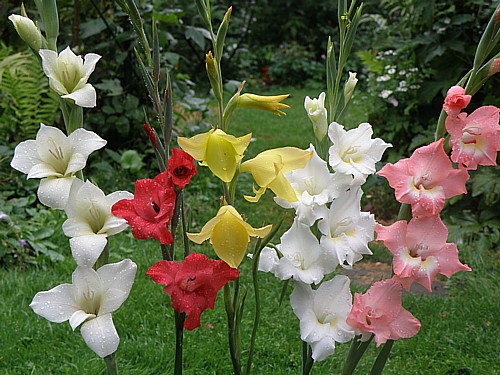History
The gladioli as being market now and
as known by the consumer have gone through a long period
of development.
In the seventeenth and eighteenth century people
discovered in South Africa strikingly large gladioli
growing in the wild. These were crossed and especially
from the Netherlands more and more varieties were put on
the market, varying in size from 50 to 170 centimeters.
Furthermore some small types were formed, Gladiolus
nanus, very elegant and beautiful varieties. Another
smaller variety are the so-called Butterfly gladioli,
they stand out from the rest thanks to their special
colour patterns.
As mentioned before, gladioli originally come from South
Africa. The people there used them as food mixed with
biological medicines. The name “gladiolus” comes from
the Latin word “gladius” which means “sword” referring
to the shape of its leaves.
The ancient Romans had their notorious gladiator fights.
It was then literally a matter of death or gladioli: the
conqueror was snowed under with gladioli. The
expression: “death or gladioli” is still used among
cycle-racers and it also became interwoven with the
“Nijmeegse Vierdaagse” ( an international four-day
walking event taking place in and around Nijmegen every
year). During this event the St.Annastreet in Nijmegen
is changed to “Via Gladiola” and those who make it to
the finish successfully are received in state with
colourful gladioli.
Abroad the sturdy, brightly coloured gladioli are very
popular as grave flowers and as basic material for large
bouquets, contrary to our country where they are not so
popular. Because most of the gladioli grown in the
Netherlands are exported to foreign countries the
growing process is therefore focused on the large red,
yellow and white varieties. In this country the small
varieties are only being marketed on a small scale.
Challa Gladiolen intends to change that and the business
now concentrates on the development of small, elegant
and colourful gladiola that can excellently be arranged
in a vase, be used in beautiful bouquets and that can
even be a welcome addition to the garden. But also in
the field of the large varieties Challa Gladiolen has in
the meantime obtained fine results.

|